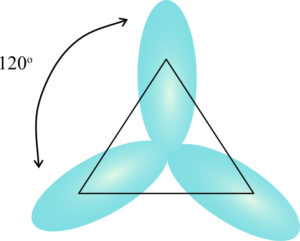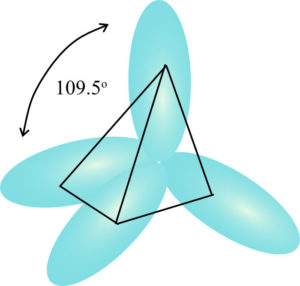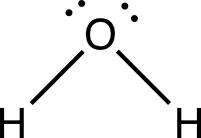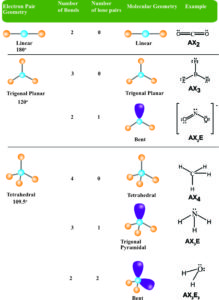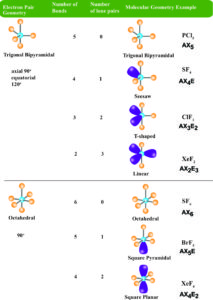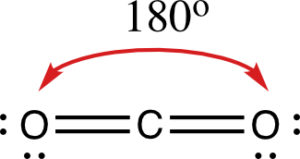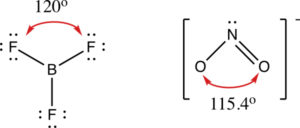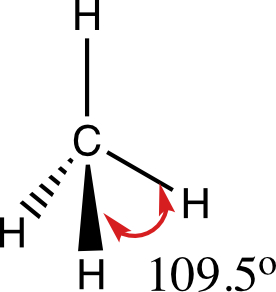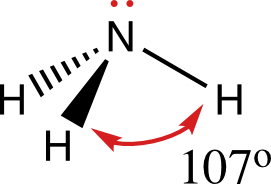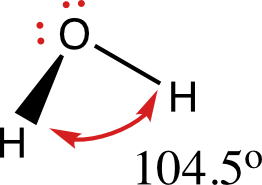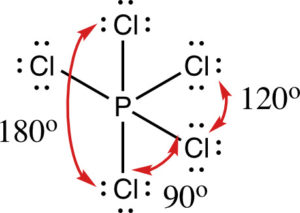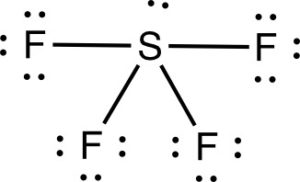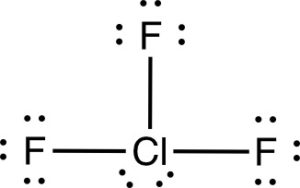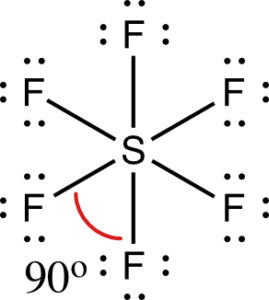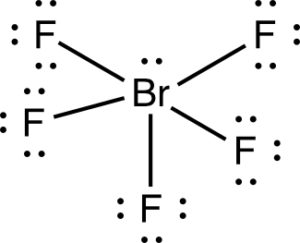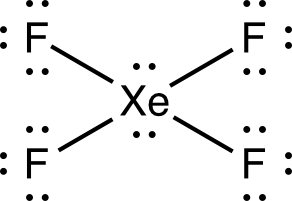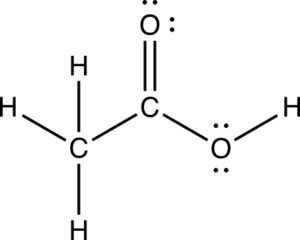Lewis structures were used previously to determine how the atoms are connected in a molecule and show where the lone pairs of electrons are located. Lewis structures do not tell us anything about molecular shape. Molecules and ions are three dimensional and we have only learned how to draw two dimensional shapes. Imagine two equal sized balloons that are tied together. The balloons will point away from one another as shown in the figure below. In fact, the balloons are 180o apart and have a linear orientation.
If we add a third balloon, we see the balloons point to the corners of an equilateral triangle with angles of 120 o apart.
If four balloons are tied together, each balloon will orient to a corner of a tetrahedron with angles of 109.5 o.
Electrons in molecules will act similarly to the balloons. The regions of electrons density, bonds and nonbonding electrons, will repel one another and therefore orient as far away from each other as they possibly can to minimize these repulsions. We use the Valence Shell Electron Pair Repulsion (VSEPR) model to predict the shapes of molecules. Here we will discuss both electron pair geometries (also called electron group or electron domain geometries) and molecular geometries (also called molecular shapes).
A group of electrons is any number of electrons that occupies a localized region around an atom. A single bond, double bond, triple bond, a lone pair, or a single electron count as a single electron group. These electron groups are referred to as charge clouds. Looking at the water molecule, we see the oxygen has 4 electron groups (charge clouds) surrounding it, two H-O bonds and two lone pairs of electrons.
The electron pair geometry is determined by the total number of charge clouds around an atom. The molecular geometry only takes into consideration the number of bonds. If the central atom does not have any lone pairs (or a single electron), the molecular geometry is the same as the electron pair geometry. It is only when there are one or more lone pairs on the central atom that molecular geometry differs from the electron pair geometry. The table below gives the electron pair geometries and molecular geometries for different molecules and ions. You will need to know the electron pair geometries and molecular geometries.
To predict electron pair geometry and molecular geometry, first draw the Lewis structure. Then count the charge clouds to determine electron pair geometry. If there are no lone pairs, the molecular geometry is the same as the electron pair geometry. If there are one or more lone pairs (or single electron), the molecular geometry is different. This is because the lone pair of electrons is only under the influence of one nucleus and have more room to spread out whereas bonding electrons are held more tightly between two nuclei. When lone pairs are involved the bond angles in the molecule become compressed. For example, for a trigonal planar molecular geometry, like BF3, the bond angles are 120o. When one of the bonds become a lone pair, the molecular geometry is bent and the bond angle is less than 120o. In fact for NO2–, a bent molecular geometry, the bond angle is 115.4o.
Discussed below are the electron pair and molecular geometries. There are five electron pair geometries: linear, trigonal planar, tetrahedral, trigonal bipyramidal, and octahedral.
Carbon dioxide has a linear electron pair geometry and a linear molecular geometry. The bonds are 180o apart.
A linear molecular shape is represented by AX2 where the letter A is the central atom, X corresponds to the bonds and E corresponds to the lone pairs of electrons that surround the central atom. In this case, there are zero lone pairs on the carbon. The subscripts indicate the number of bonds and lone pairs. Any substance with two atoms bonded to a central atom with zero lone pairs of electrons has a linear electron pair geometry and a linear molecular shape.
Trigonal Planar Electron Pair Geometry and Molecular Shape
Boron trifluoride, BF3, has a trigonal planar electron pair geometry with bond angles of 120o. There are three charge clouds and zero lone pairs of electrons on the boron atom. The molecular geometry is also trigonal planar and is represented by AX3. The nitrite ion, NO2–, also has a trigonal planar electron pair geometry — there are three charge clouds. Two of them are bonds and there is a lone pair of electrons on the nitrogen atom. The molecular geometry is bent due to the lone pair of electrons compressing the bond angles to 115.4o and is represented by AX2E.
Tetrahedral Electron Pair Geometry and Molecular Shapes
Methane, CH4, has a tetrahedral electron pair geometry and a tetrahedral molecular geometry, AX4. The bond angles are 109.5o. A tetrahedral geometry has 4 charge clouds.
Note the structure for methane. This represents the three dimensional structure. The solid lines are in the plane of the paper, the dashed wedge is coming out of the paper toward you, and the solid wedge is going through the back of the paper away from you.
Ammonia has a tetrahedral electron pair geometry — it has 4 charge clouds with 3 bonds and one lone pair of electrons, AX3E. The molecular shape is trigonal pyramidal and the bond angles are 107o.
Water has a tetrahedral electron pair geometry because it has 4 charge clouds — 2 bonds and 2 lone pairs of electrons. But, its molecular shape is bent, because two of the charge clouds are lone pairs. This is the case for all molecules and ions that are AX2E2. The bond angle is 104.5o. Note, the bond angles decrease with increasing lone pairs of electrons.
Expanded Valence Shells
Elements after the second period can be surrounded by more than an octet of electrons. They can have 5 or 6 charge clouds. For example, PCl3 has 4 charge clouds and PCl5 has 5 charge clouds. If there are 5 charge clouds, the molecule or ion will have a trigonal bipyramidal electron pair geometry. If 6 charge clouds are present, the electron pair geometry is octahedral.
The molecule, PCl5, has a trigonal bipyramidal electron pair geometry, AX5. The trigonal bipyramid has two trigonal pyramids that share one base. There are 5 charge clouds with no lone pairs of electrons on P. There are two types of bonds — axial and equatorial. The axial bonds are the the two bonds that are 180o apart. The equatorial bonds are the three bonds that are 120o.
The bond angle between an axial bond and equatorial bond is 90o. If lone pairs are included, they will always take an equatorial position since there is more room. The molecular geometry for PCl5 is trigonal bipyramidal.
Sulfur tetrafluoride, SF5, has 5 charge clouds — four bonds and 1 lone electron pair. It can be represented by AX4E with an electron pair geometry of trigonal bipyramidal. The lone pair is in an equatorial position, and the molecular geometry is seesaw.
Chlorine trifluoride, ClF3, has a trigonal bipyramidal electron pair geometry. The molecular geometry is t-shape, AX3E2. The two lone pairs of electrons are in equatorial positions.
Xenon difluoride, XeF2, has a trigonal bipyramidal electron pair geometry. The three lone pairs of electrons are in equatorial positions. The molecular shape is linear. The VSEPR representation is AX2E3.
Octahedral Electron Pair Geometry and Molecular Shapes
An octahedral electron pair geometry and molecular geometry will have 6 charge clouds. An octahedron has 8 faces, each an equilateral triangle. All of the bond angles are 90o. An octahedral geometry is represented by AX6. Sulfur hexafluoride, SF6 has an octahedral electron pair and molecular geometry.
Bromine pentafluoride, BrF5 has an octahedral electron pair geometry, AX6. Because there is one lone pair of electrons on the Br, it has a square pyramidal molecular shape, AX5E.
Xenon tetrafluoride, Xe4, has an octahedral electron pair geometry. There are 6 charge clouds and the VSEPR representation is AX6. The two lone pairs of electrons make the molecular geometry a square planar, AX4E2.
Molecules With More Than One Central Atom
The substances we have looked at so far have only one central atom. We can apply the same principles to many atom molecules. One example is acetic acid. We can predict the electron pair geometries and molecular geometries of the two carbon atoms and the oxygen in the compound.
The first carbon is bonded to 4 groups, and the electron pair geometry and molecular geometry are tetrahedral with bond angles of 109.5o. The second carbon is bonded to three groups with zero lone pairs. The electron pair geometry and molecular geometry is trigonal planar with bond angles of 120o. The oxygen is bonded to 2 groups and has 2 lone pairs of electrons. The electron pair geometry is tetrahedral, but the molecular geometry is bent with bond angles of 104.5o.
Worksheet: Electron Pair Geometry and Molecular Geometry
Worksheet: Electron Pair and Molecular Geometries Part 2
Worksheet: Electron Pair and Molecular Geometries Part 3
Exercises
Exercise 1. Predict both the electron pair geometry and shape of SbF5–.
Exercise 2. Predict both the electron pair geometry and shape of SO2Cl2.
Exercise 3. What shape would you predict for the following ions?
b) SCN–
c) CrO42-
d) ClO4–
Exercise 4. What is the electron pair geometry and the shape of SO3?
Exercise 5. What are the bond angles in PH3?
Exercise 6. What are the bond angles in SCN–?
Exercise 7. What is the molecular shape of a molecule that is AX2E3?
Check Solutions to Exercise 7
Back to Bonding Models for Covalent Compounds
Back to General Chemistry 1 Study Guides
Back to Home Page


